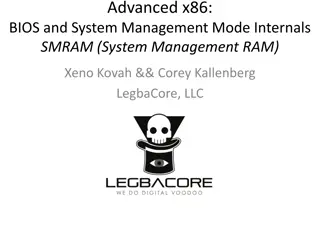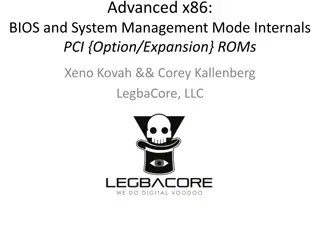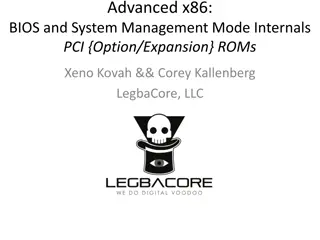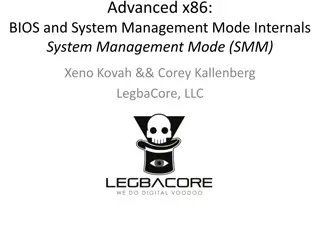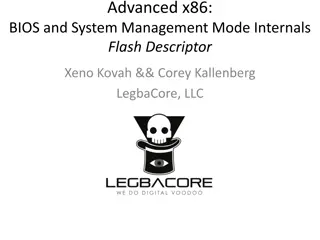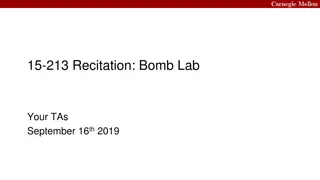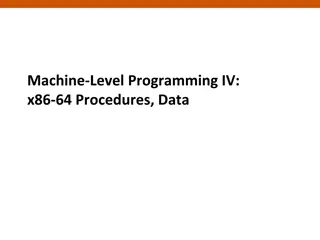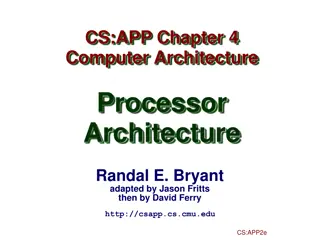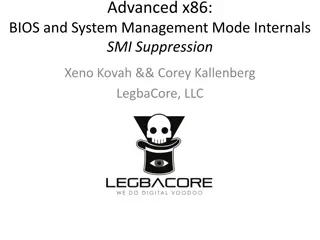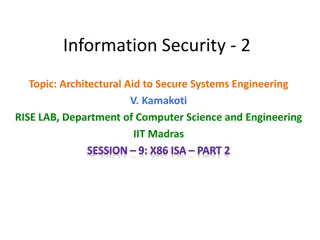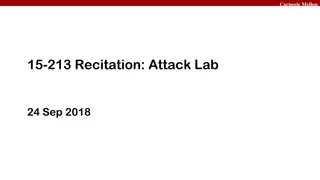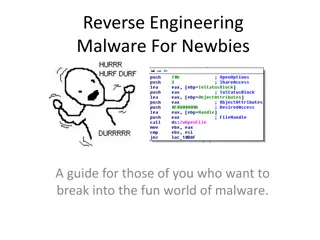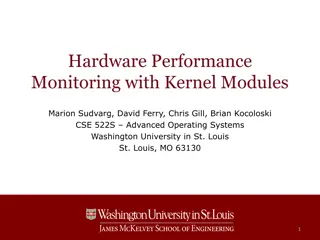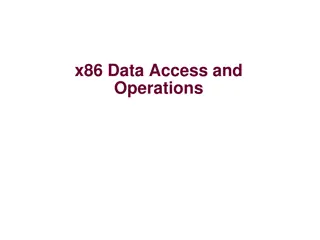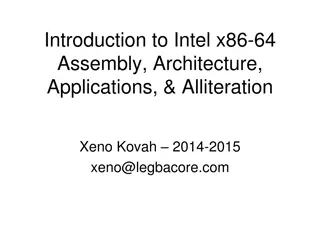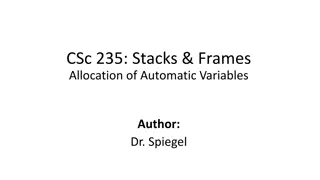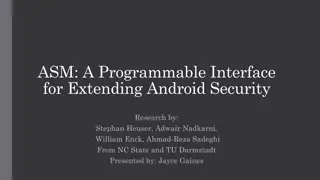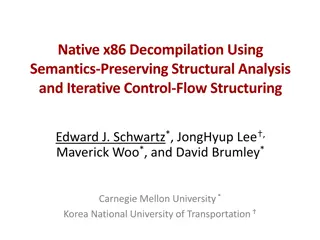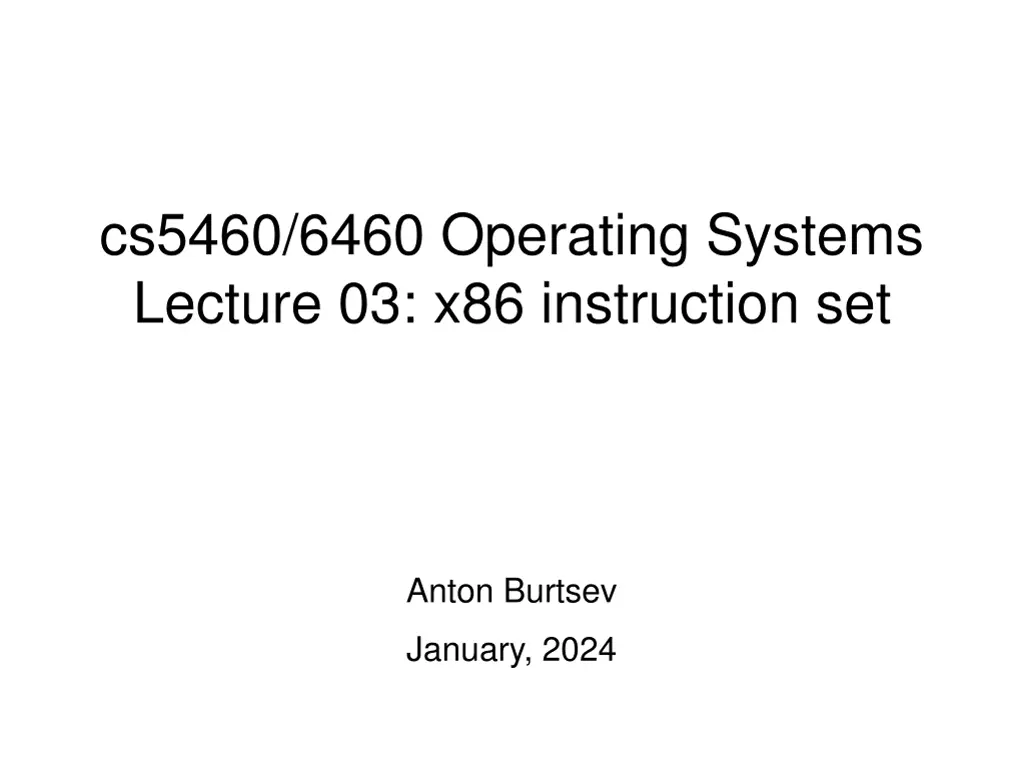
Understanding x86 Instruction Set in Operating Systems
Explore the basics of x86 instruction set in operating systems, including CPU execution, data movement, arithmetic operations, and control flow. Discover the general registers' roles and learn about where these essential components are located.
Download Presentation

Please find below an Image/Link to download the presentation.
The content on the website is provided AS IS for your information and personal use only. It may not be sold, licensed, or shared on other websites without obtaining consent from the author. If you encounter any issues during the download, it is possible that the publisher has removed the file from their server.
You are allowed to download the files provided on this website for personal or commercial use, subject to the condition that they are used lawfully. All files are the property of their respective owners.
The content on the website is provided AS IS for your information and personal use only. It may not be sold, licensed, or shared on other websites without obtaining consent from the author.
E N D
Presentation Transcript
cs5460/6460 Operating Systems Lecture 03: x86 instruction set Anton Burtsev January, 2024
CPU execution loop CPU repeatedly reads instructions from memory Executes them Example ADD EDX, EAX // EDX = EAX + EDX
What are those instructions? (a brief introduction to x86 instruction set) This part is based on David Evans x86 Assembly Guide http://www.cs.virginia.edu/~evans/cs216/guides/x86.html and Yale FLINT s group version of the same manual converted to GNU ASM syntax https://flint.cs.yale.edu/cs421/papers/x86-asm/asm.html
Note We ll be talking about 32bit x86 instruction set The version of xv6 we will be using in this class is a 32bit operating system You re welcome to take a look at the 64bit port
x86 instruction set The full x86 instruction set is large and complex But don t worry, the core part is simple The rest are various extensions (often you can guess what they do, or quickly look it up in the manual)
x86 instruction set Three main groups Data movement (from memory and between registers) Arithmetic operations (addition, subtraction, etc.) Control flow (jumps, function calls)
General registers 8 general registers 32bits each Two (ESP and EBP) have a special role Others are more or less general Used in arithmetic instructions, control flow decisions, passing arguments to functions, etc.
We use the following notation <reg32> Any 32-bit register (EAX,EBX,ECX,EDX,ESI,EDI,ESP,EBP) <reg16> Any 16-bit register (AX, BX, CX, or DX) <reg8> Any 8-bit register (AH, BH, CH, DH, AL, BL, CL, DL) <reg> Any register <mem> A memory address (e.g., [eax], [var + 4], or dword ptr [eax+ebx]) <con32> Any 32-bit constant <con16> Any 16-bit constant <con8> Any 8-bit constant <con> Any 8-, 16-, or 32-bit constant
mov instruciton Copies the data item referred to by its second operand (i.e. register contents, memory contents, or a constant value) into the location referred to by its first operand (i.e. a register or memory). Register-to-register moves are possible Direct memory-to-memory moves are not Syntax mov <reg>,<reg> mov <reg>,<mem> mov <mem>,<reg> mov <reg>,<const> mov <mem>,<const>
mov examples mov eax, ebx ; copy the value in ebx into eax mov byte ptr [var], 5 ; store 5 into the byte at location var mov eax, [ebx] ; Move the 4 bytes in memory at the address ; contained in EBX into EAX mov [var], ebx ; Move the contents of EBX into the 4 bytes ; at memory address var. ; (Note, var is a 32-bit constant). mov eax, [esi-4] ; Move 4 bytes at memory address ESI + (-4) ; into EAX mov [esi+eax], cl ; Move the contents of CL into the byte at ; address ESI+EAX
mov: access to data structures struct point { int x; // x coordinate (4 bytes) int y; // y coordinate (4 bytes) } struct point points[128]; // array of 128 points // load y coordinate of i-th point into y int y = points[i].y; ; ebx is address of the points array, eax is i mov edx, [ebx + 8*eax + 4] ; Move y of the i-th ; point into edx
lea load effective address The lea instruction places the address specified by its second operand into the register specified by its first operand The contents of the memory location are not loaded, only the effective address is computed and placed into the register This is useful for obtaining a pointer into a memory region
lea vs mov access to data structures mov // load y coordinate of i-th point into y int y = points[i].y; ; ebx is address of the points array, eax is i mov edx, [ebx + 8*eax + 4] ; Move y of the i-th point into edx lea // load the address of the y coordinate of the i-th point into p int *p = &points[i].y; ; ebx is address of the points array, eax is i lea esi, [ebx + 8*eax + 4] ; Move address of y of the i-th point ; into esi
lea is often used instead of add Compared to add, lea can perform addition with either two or three operands store the result in any register; not just one of the source operands. Examples LEA EAX, [ EAX + EBX + 1234567 ] ; EAX = EAX + EBX + 1234567 (three operands) LEA EAX, [ EBX + ECX ] ; EAX = EBX + ECX ; Add without overriding EBX or ECX with the result LEA EAX, [ EBX + N * EBX ] ; multiplication by constant ; (limited set, by 2, 3, 4, 5, 8, and 9 since N is ; limited to 1,2,4, and 8).
add Integer addition The add instruction adds together its two operands, storing the result in its first operand Both operands may be registers At most one operand may be a memory location Syntax add <reg>,<reg> add <reg>,<mem> add <mem>,<reg> add <reg>,<con> add <mem>,<con>
add examples add eax, 10 ; EAX EAX + 10 add BYTE PTR [var], 10 ; add 10 to the ; single byte stored at ; memory address var
sub Integer subtraction The sub instruction stores in the value of its first operand the result of subtracting the value of its second operand from the value of its first operand. Examples sub al, ah ; AL AL - AH sub eax, 216 ; subtract 216 from the value ; stored in EAX
inc, dec Increment, decrement The inc instruction increments the contents of its operand by one The dec instruction decrements the contents of its operand by one Examples dec eax ; subtract one from the contents ; of EAX inc DWORD PTR [var] ; add one to the 32- ; bit integer stored at ; location var
and, or, xor Bitwise logical and, or, and exclusive or These instructions perform the specified logical operation (logical bitwise and, or, and exclusive or, respectively) on their operands, placing the result in the first operand location Examples and eax, 0fH ; clear all but the last 4 ; bits of EAX xor edx, edx ; set the contents of EDX to ; zero
shl, shr shift left, shift right These instructions shift the bits in their first operand's contents left and right, padding the resulting empty bit positions with zeros The shifted operand can be shifted up to 31 places. The number of bits to shift is specified by the second operand, which can be either an 8-bit constant or the register CL In either case, shifts counts of greater then 31 are performed modulo 32. Examples shl eax, 1 ; Multiply the value of EAX by 2 ; (if the most significant bit is 0) shr ebx, cl ; Store in EBX the floor of result of dividing ; the value of EBX by 2^n ; where n is the value in CL.
More instructions (similar) Multiplication imul imul eax, [var] ; multiply the contents of EAX by the ; 32-bit contents of the memory ; location var. Store result in EAX imul esi, edi, 25 ; ESI EDI * 25 Division idiv not - bitvise logical not (flips all bits) neg - negation neg eax ; EAX - EAX
Poll Q1: What is inside ebx? After we execute the mov instruction? ; eax = 2 ; ebx = 3 mov ebx, eax ; what is the value of eax here?
Poll Q2: What is this instruction doing? mov ebx, [eax] ; Is it writing memory? Or reading it?
Poll Q3: Is this a legal instruction mov [ebx], [eax]
EIP instruction pointer EIP is a 32bit value indicating the location in memory where the current instruction starts (i.e., memory address of the instruction) EIP cannot be changed directly Normally, it increments to point to the next instruction in memory But it can be updated implicitly by provided control flow instructions
Labels <label> refers to a labeled location in the program text (code). Labels can be inserted anywhere in x86 assembly code text by entering a label name followed by a colon Examples mov esi, [ebp+8] begin: xor ecx, ecx mov eax, [esi]
jump: jump Transfers program control flow to the instruction at the memory location indicated by the operand. Syntax jmp <label> Example begin: xor ecx, ecx ... jmp begin ; jump to instruction labeled ; begin
jcondition: conditional jump Jumps only if a condition is true The status of a set of condition codes that are stored in a special register (EFLAGS) EFLAGS stores information about the last arithmetic operation performedm for example, Bit 6 of EFLAGS indicates if the last result was zero Bit 7 indicates if the last result was negative Based on these bits, different conditional jumps can be performed For example, the jz instruction performs a jump to the specified operand label if the result of the last arithmetic operation was zero Otherwise, control proceeds to the next instruction in sequence
Conditional jumps Most conditional jump follow the comparison instruction (cmp, we ll cover it below) Syntax je <label> (jump when equal) jne <label> (jump when not equal) jz <label> (jump when last result was zero) jg <label> (jump when greater than) jge <label> (jump when greater than or equal to) jl <label> (jump when less than) jle <label> (jump when less than or equal to) Example: if EAX is less than or equal to EBX, jump to the label done. Otherwise, continue to the next instruction cmp eax, ebx jle done
cmp: compare Compare the values of the two specified operands, setting the condition codes in EFLAGS This instruction is equivalent to the sub instruction, except the result of the subtraction is discarded instead of replacing the first operand. Syntax cmp <reg>,<reg> cmp <reg>,<mem> cmp <mem>,<reg> cmp <reg>,<con> Example: if the 4 bytes stored at location var are equal to the 4-byte integer constant 10, jump to the location labeled loop. cmp DWORD PTR [var], 10 jeq loop
Stack It's just a region of memory Pointed by a special register ESP You can change ESP Get a new stack
Calling functions Functions can be called from different places in the program if (a == 0) { foo(); // some code... foo(); // more code.. Stack contains information for how to return from a subroutine i.e., from foo() } else { foo(); }
Stack Main purpose: Store the return address for the current procedure Caller pushes return address on the stack Callee pops it and jumps
Stack Main purpose: Store the return address for the current procedure Caller pushes return address on the stack Callee pops it and jumps
Call/return CALL instruction Makes an unconditional jump to a subprogram and pushes the address of the next instruction on the stack push eip + sizeof(CALL) ; save return ; address jmp _my_function RET instruction Pops off an address and jumps to that address

